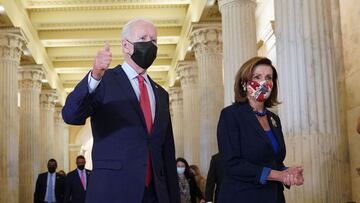How many unemployment claims have there been in September 2021?
Despite reaching pandemic-era lows, hundreds of thousands of Americans filed initial jobless claims in September, as well as a growth in the final week.


September saw more than 1 million new applications for unemployment benefits, a large number but well below previous pandemic months. If all weekly applications are added together, the total is 1.36 million applications. Not all of these will be accepted however, due to the terms of benefit eligibility that many people who have been on the expanded pandemic benefits will be unable to claim.
“What we’re seeing is a labor market that continues to get better but we’re still dealing with high levels of unemployment,” said Gus Faucher, chief economist at Pennsylvania-based PNC Financial Services Group.
The monthly average, to smooth out volatility in the figures, was 340,000, just above the lowest level since the covid-19 pandemic began. Despite the lows, they still remain far above the pre-pandemic average of 218,000.
Related news:
- Which states will pay additional stimulus money in October 2021?
- Unemployment benefits: has the claim for payments decreased in September?
- Can self-employed workers qualify for a new round of payments?
- Unemployment benefits: is the end of payments helping people find work?
Initial claims are not the whole story
The number of continuing claims for benefits fell sharply in early September, as the extended unemployment benefits during the pandemic wound down nationwide. Overall continuing claims fell to 5 million the week ended September 11 from 11.3 million the previous week. There are delays in reporting the data, so it will take some more months before the full picture can be ascertained.
Significant drop in total number of individuals claiming unemployment (5m vs. 11.3m in prior week) … data lagged a bit so now just reflecting rolling back of enhanced unemployment benefits pic.twitter.com/aZAqA1LS14
— Liz Ann Sonders (@LizAnnSonders) October 1, 2021
At their height in August 2020, more than 16 million continuing claims were made to the main two pandemic programs.
Why might unemployment claims be on the rise in future?
The last two weeks of September saw a slight rise in initial claims. The ending of extra unemployment benefits on Labor Day could lead to more people requiring further support. A part of this was the extra $300 weekly payment and an expansion to the number of weeks unemployed people can claim benefits. With this gone, many long-term unemployed are now eligible for very little support.
Related stories
The US is currently in the midst of a historic number of job vacancies, with July having more than 10.7 million available jobs. The lack of a rush to fill them once the extra support ended shows there are further reasons than the benefits as to why people are not back in work. The necessity of childcare and high levels of covid-19 have been posited as reasons for the hesitancy.
We need to be real. 2,000 people are dying every single day from COVID-19.
— Congresswoman Cori Bush (@RepCori) September 27, 2021
This is still a raging public health crisis. We need to bring back public health measures that keep people safe.
Stimulus checks, unemployment benefits, eviction moratorium — to name a few.
“The idea was that there were lots of jobs, it was just that people weren’t looking. That was the narrative,” said Arindrajit Dube, a University of Massachusetts economist who authored a study on why people are staying out of work. “I don’t think that story holds up.”

